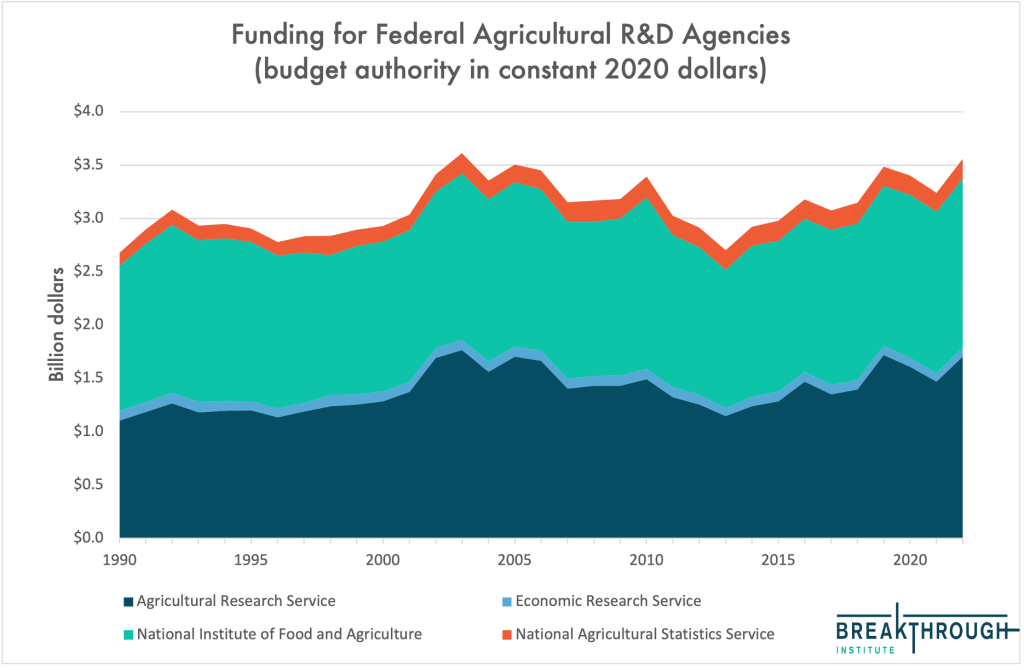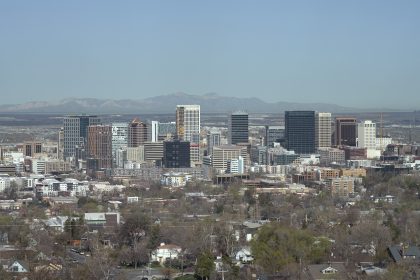Federal Ag Innovation Funding Rose This Year, but Still Lags
COMMENTARY | The Ecomodernist

According to the latest United Nations IPCC report on mitigating climate change, improvements in agriculture and forestry could deliver up to 30% of the cuts in greenhouse gas emissions needed to meet global climate targets. This represents a huge opportunity to meet our climate goals, but would require a 600-fold increase in funding for mitigation in the agriculture and forestry sectors.
Congress’ latest spending bill, passed with a bipartisan majority and signed into law on March 15 by President Joe Biden, is an important step toward ramping up this essential funding. It increased agricultural research and development funding more than in almost any other year.
Yet agricultural R&D remains underfunded. Inflation-adjusted funding levels for agricultural R&D are lower than they were at their peak in 2003. In contrast, the Department of Energy’s budget for energy research, development and deployment doubled from the early 2000s to over $8 billion in 2021. To address the myriad challenges facing agriculture today, including decarbonization, R&D funding should at least be doubled.
Government funding for agricultural R&D is crucial to cutting greenhouse gas emissions. Since the 1960s, federally-supported advances in soil science, crop genetics, animal health and other fields have helped farmers shrink land use by 9% and cut the carbon footprint of milk, beef, chicken and many other products. However, the food system — including farming, agriculturally driven deforestation, food processing, transportation and other activities — still accounts for 23%-42% of global emissions and about 21% of U.S. emissions.
Moving forward, more R&D is needed to develop technologies that cut emissions from major sources such as synthetic fertilizer and enteric fermentation (i.e. cow burps), to improve low-carbon and affordable alternative proteins like cultivated meat, and to create tools that better measure and monitor greenhouse gas emissions, among other things. Additional funding is also needed for breeding and genetics programs to increase crop and livestock yields, and thus reduce the amount of land needed.
We estimate that the productivity enhancements from doubling U.S. government agricultural R&D spending would reduce global GHG emissions, relative to a business-as-usual scenario, by at least 109 million metric tons of carbon dioxide-equivalent per year by 2050. And research breakthroughs, such as improvements to photosynthetic efficiency that boost yields for major crops, could reduce emissions even further, by more than 200 million tons of carbon dioxide-equivalent per year.
The $1.5 trillion federal spending bill that Biden signed into law last month substantially boosted major agricultural R&D programs and agencies. Overall, it increased funding for agricultural R&D agencies by about 9%, or $310 million above 2021 levels.

The bill provides a $234 million, or 15.3%, funding increase for the Agricultural Research Service, which conducts in-house research in partnership with universities across all 50 states. This includes critical research on crop and livestock production, helping increase productivity and climate resilience.
Nearly one-fifth of ARS funding also goes toward its Natural Resources and Sustainable Agriculture Systems program, supporting projects such as an effort to assess how different cattle feeds can reduce methane emissions. Much of the funding increase is for ARS buildings and facilities, which face a roughly $1 billion maintenance backlog.
Unfortunately, funding only rose by 2.3%, to $445 million, for the Agriculture and Food Research Initiative, the flagship competitive grant-making program for agricultural research. This is far less than the program needs to fund high-priority research.
Over half of the projects that AFRI’s expert review panel recommends are not funded due to financial constraints. The Department of Agriculture requested $564 million for next year and has previously requested $700 million. Such an increase would have large economic benefits. According to a recent study, every dollar invested in public agricultural research generates $20 in value for consumers, farmers and businesses.
It would also have enormous environmental benefits. AFRI provides over $100 million to projects broadly related to environmental sustainability. In 2021, AFRI-funded projects focused on topics including:
- Sustaining water resources under a changing climate.
- Incorporation of photovoltaic solar generation and crop production.
- Enhancing crop climate resilience through perennial ground cover and diversification.
- Using marine algae to reduce enteric methane emissions from milk production.
- Developing new cultivated meat systems.
The spending bill also provides $1 million to establish a new agricultural research agency, the Agriculture Advanced Research and Development Authority. AgARDA, formally authorized in the 2018 Farm Bill but not funded until now, is modeled after other advanced R&D agencies such as the Defense Advanced Research Projects Agency and the Advanced Research Projects Agency–Energy.
It is meant to fund grants and cooperative research on a broad range of basic and applied research topics aimed at improving environmental sustainability, resilience to extreme weather, national food security and international export competitiveness.
While the initial funding is a sign that Congress recognizes the importance of agricultural R&D, it is paltry compared with the $76 million per year in funding for AgARDA the House proposed in the Build Back Better Act. It is also far less than the $450 million allocated to ARPA-E, the Department of Energy agency charged with funding research on advanced energy technologies.
Ultimately, the world will not reach net-zero greenhouse gas emissions without transforming its food system. Developing and disseminating affordable, productive and low-carbon agricultural technologies must be a priority for addressing climate change.
Current funding levels are far from sufficient to meet the challenge. Future legislation — not only spending bills but also packages such as the farm bill or bills focused on climate innovation — must raise the bar, putting the country on a clear path to double agricultural R&D the way we have seen funding rise for other critical areas.
Daniel Blaustein-Rejto is the director of the food and agriculture program. You can reach him on Twitter @danrejto.
Caroline Grunewald is a government affairs manager in the food and agriculture program. You can reach her on Twitter @caro_grunewald.






















